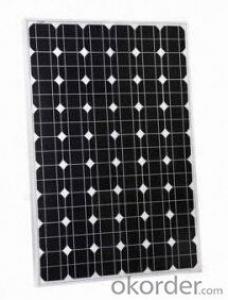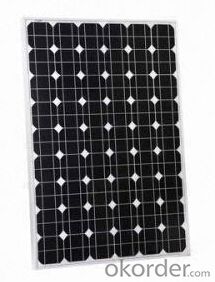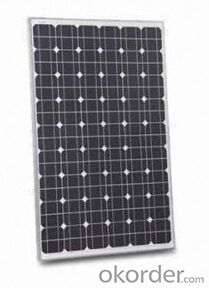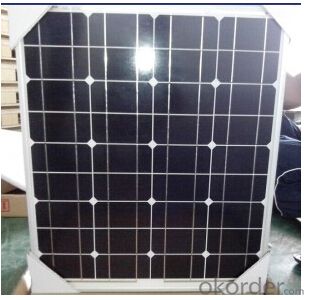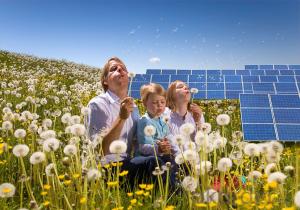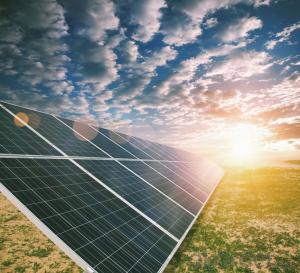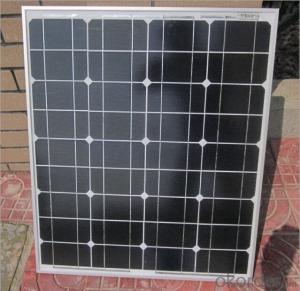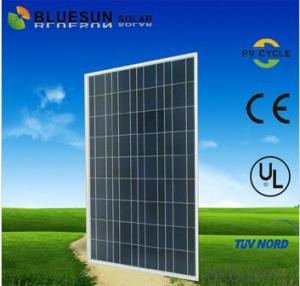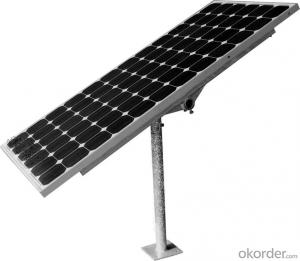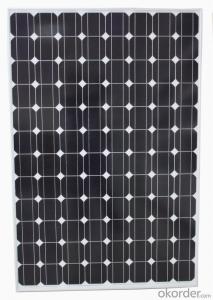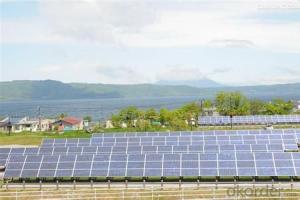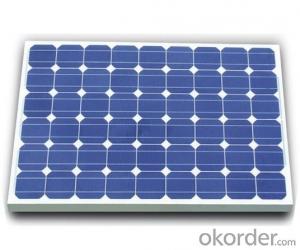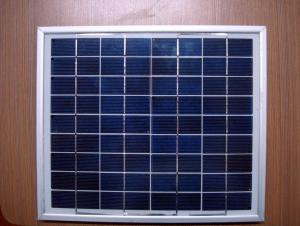HJT Solar Panels - Monocrystalline Silicon 40W
- Loading Port:
- Shanghai
- Payment Terms:
- TT OR LC
- Min Order Qty:
- 100 pc
- Supply Capability:
- 100000 pc/month
OKorder Service Pledge
OKorder Financial Service
You Might Also Like
Description:
Monocrystalline Silicon Solar Panel 120W : High efficiency crystalline solar cell. Even if under the weak light, the solar module can produce maximum power output.
II Tempered glass (toughened glass): Anti-reflecting coating and high transmission rate glass increase the power output and mechanical strength of solar module.
III EVA and TPT: Using high quality EVA and TPT to prevent destroying and water.
IV AI frame: Without screw, rner connection. 6 holes on the frame can be installed easily.
V Junction box: Multi function junction box with water proof.
VI Long lifetime: ≥25 years; Less power decrease.
VII Good performance of preventing from atrocious weather such as wind and hails.
VIII Resisting moisture and etching effectively, not effected by geology.
Standard Test Conditions of Monocrystalline Silicon Solar Panel 120W :
The opto-electrical specifications shown below are stabilized values being measured at Standard Test Conditions, Irradiance: 1000W/m2, Spectrum: AM1.5 at 25°C, The info below is subject to manufacturing tolerances. Where appropriate minutes of measurement are available and are used for the dimensioning of the installation.
Advantages of Monocrystalline Silicon Solar Panel
• CNBM Solar performance guarantees for 25 years
• 12 years guarantee for workmanship
• Timeliness of delivery
Specification of Solar Monocrystalline 125mm Series
Characteristics
Max Power Voltage Vmp (V) 17.2V
Max Power Current Imp (A) 2.33A
Open Circuit Voltage Voc (V) 22.2V
Short Circuit Current Isc (A) 2.48A
Max Power Pm (W) 40W
Temperature Coefficient of Cells
NOCT 47℃±2℃
Temperature Coefficients of Isc (%/℃) +0.06%
Temperature Coefficients of Voc (%/℃) -0.32%
Temperature Coefficients of Pmp (%/℃) -0.45%
Mechanical Data
Type of Cells(mm) mono156×44.6
Dimension 610×510×25mm
Weight 3.7kg
NO. of Cells and Connections 3×12=36
The dimension of the modules can be changed according to the demand of clients
Limits
Operating Temperature –45 °C to +80°C
Storage Temperature –45 °C to +80°C
Max System Voltage 700V
Guarantee
Products Guarantee 2 yrs free from defects in materials andworkmanship
Performance Guarantee No less than 90% within 10yrs and no lessthan 80% within 20yrs

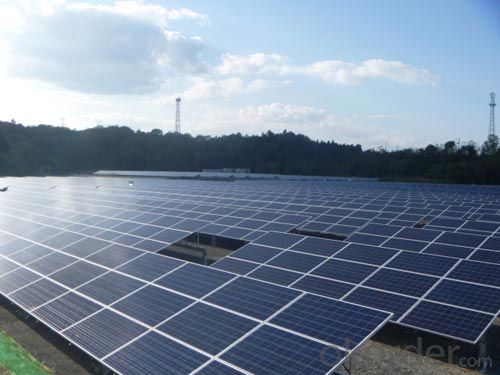
FAQ
We have organized several common questions for our clients,may help you sincerely:
①How to guarantee the quality of the products?
CNBM Solar performance guarantees for 25 years
• 12 years guarantee for workmanship
• Timeliness of delivery
• Quality Products certified (TÜV, UL, CE, ISO)
②How long can we receive the product after purchase?
In the purchase of product within three working days, We will arrange the factory delivery as soon as possible. The pecific time of receiving is related to the state and position of customers.Commonly 7 to 10 working days can be served.
- Q: was looking at a few different sites, here is one of them
- I had a system installed recently, so I would suggest starting by getting a quote from a licensed contractor. Even if you are planning on doing the installation yourself, a contractor will have a lot of useful info. I got 3 quotes and they were all about the same cost. I was able to get a 2 year usage history from our utility so the contractors were able to suggest a system based on that. They were able to tell me about rebates and tax credits, were the best location would be and the estimated amount of production. They have a nifty gadget that can tell if there will be any shade cast on the roof at any time during the year. I decided to maximize my rebates and got a system that reduced my utility bill by about 50%, although my production has cut it much more than that, my highest electric bill was $35, and that was in Dec. with cloudy short days. I got a $0K rebate and a $2K tax credit. This year the fed. tax credit is 30% of the total installed price. My system cost $26K, I paid $6K out of pocket and I'm saving about $2K per year.
- Q: Can solar panels be used to heat water?
- Yes, solar panels can be used to heat water. Solar water heaters use the energy from the sun to heat water, typically through the use of solar thermal collectors. These collectors absorb solar radiation and transfer the heat to a liquid, which is then circulated to heat the water. This renewable and environmentally friendly method can be used for residential and commercial purposes to provide hot water.
- Q: All I want to power is a small ice-maker (250 watts) for 25 minutes per day. That's all!!!Can I do that by using a 00 watt panel with 2-3 deep cycle batteries and getting 0 hours of quality light per day.(BTW) what size converter would you recommend? I want more than I need to grow the system
- You okorder /
- Q: 3.8 volts is required to fully charge a battery. But at 3.8 volts, the battery can be overcharged without the use of a controller correct? What if I don't care if the battery is fully charged? In the case of our family boat, I just installed a new radio, so I'm a little worried about power consumption. So now for the real question; If I hook a 2 volt panel to the batteries, do I need to worry about overcharging them? Or will the batteries stop the charging process once they reach 2 volt?I built the panel myself, it's 8 volts at 3.5 amps open circuit. I have tabs at every 3 volt increment on the panel so that I can use less voltage than 8 if I want to power something directly, (ex:2 volt radio)So I'm using the 2 volt tab at 3.5 amps(approx) for a total of approx 48 watts
- Batteries will not stop charging on their own. The will stop charging when the battery voltage equals the supply voltage. Solar panel open circuit voltage is typically around 20V. Batteries will just boil dry before reaching 20V. One rule of thumb, above 0W you need a controller for sure.
- Q: I was thinking of having some installed on our rooftop and was wondering if it would be worth the cost? The house is located in Sac, Cali. The panels would face the sun 2 months out of the year and in the summer roughly 4 hours of straight sun.
- You can log in alibaba,i purchased about 20000watts 2 years ago and solar panels work efficiency is fairly high. I hope my answer help you !
- Q: Are solar panels suitable for residential use?
- Yes, solar panels are highly suitable for residential use. They are cost-effective, environmentally friendly, and can significantly reduce electricity bills. With advancements in technology and decreasing panel prices, solar panels have become an attractive option for homeowners to generate clean, renewable energy and contribute to a sustainable future.
- Q: Dear Friends, I am very much worried about Global warming, So to contribute something for reducing Global Warming I have decided to use Solar Panels. Can anybody tell me what is the price of these Solar Panels and why people are not using them when they are environment friendly. What are the Pros and Cons of these Solar Panels?
- A 35 Watt Solar Panel cost between 400 and 500 depending on where you make the deal. I live full time in an RV and I get all my electric from the Sun. I am sold on solar but I move around to places, according to the season, where I will have full sun most of the time. I also have a small generator as a back up but rarely use it. The amount of direct sun and angle of the panels will determine how efficient they are. For some one living in an apartment with only a few hours of sun then solar would not be good for them.
- Q: Can solar panels be used for powering a hospital or healthcare facility?
- Yes, solar panels can be used for powering a hospital or healthcare facility. Solar energy can provide a reliable and sustainable source of electricity for various healthcare operations, including lighting, equipment, and critical medical devices. By harnessing solar power, hospitals can reduce their dependency on traditional energy sources, lower operational costs, and contribute to a greener environment.
- Q: Can solar panels generate electricity during a blackout?
- No, solar panels cannot generate electricity during a blackout. This is because most solar panel systems are grid-tied and rely on the electricity from the power grid to function. When there is a blackout, the grid-tied solar panels automatically shut off to prevent any electricity from flowing back into the grid, in order to protect utility workers who may be repairing the power lines. However, it is possible to have a backup battery system installed along with the solar panels, which can store excess energy and provide electricity during a blackout.
- Q: Can solar panels be installed on drones?
- Yes, solar panels can be installed on drones.
Send your message to us
HJT Solar Panels - Monocrystalline Silicon 40W
- Loading Port:
- Shanghai
- Payment Terms:
- TT OR LC
- Min Order Qty:
- 100 pc
- Supply Capability:
- 100000 pc/month
OKorder Service Pledge
OKorder Financial Service
Similar products
Hot products
Hot Searches
Related keywords
